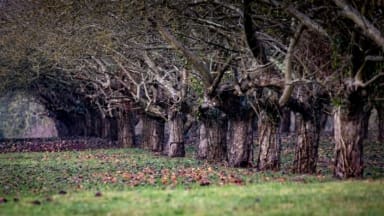
Undisturbed since it was planted in 1922, rich in flora and fauna, and a biodiversity hotspot, Coton Orchard is home to a mix of fruit trees, meadow, hedgerows, wild scrub, copse, and collection of 100-year old Bramley apple trees.
At a costs of minimum £200 million, the Greater Cambridge Partnership (GCP) intends to build a new busway from Cambourne to Cambridge (C2C) which will cut through fields, woodland and the ancient Coton orchard, irreversibly changing the landscape, views and habitats. The ‘off-road’ scheme involves laying a 30-metre road, across the site and removing a section of orchard that also contains the 100-year old Bramleys. Coton Orchard said it would cost the orchard around 500 historic trees.
Campaigners argue that there is a viable alternative route, along existing transport corridors, which would save the orchard, be less damaging and offer better journeys to respective destinations. However, the GCP say that the new 8 mile, Cambourne to Cambridge link would help connect people living in planned housing development and encourage drivers to switch to taking the bus, to avoid hitting congestion in Cambridge.
Local residents are not happy as the plans for the new bus road has been consistently rejected by the general public at every stage of consultation, but the GCP seem adamant to pursue the plans. Opponents to the new bus route include the National Trust, the Woodland Trust, Sir David Attenborough, Chris Packham and the Wildlife Trust for Bedfordshire, Cambridgeshire & Northamptonshire.
“The National Trust continues to object to the proposal for an off-road busway between Madingley Mulch and Cambridge city centre because of its impact on a valued landscape which has intrinsic visual, historic and cultural significance, and which is fundamental to preserving the setting and special character of the historic city of Cambridge in accordance with its Green Belt purpose,” stated the National Trust
Actions to save the orchard includes the petition by the charity Cambridge Past, Present and Future, supported by organisations such as the Parish Councils of Coton and Hardwick, the Coton Busway Action Group, Coton Loves Pollinators and Save the West Fields. The petition has to date received over 23,000 signatures.
In addition, Cambridge Past, Present and Future has begun legal proceedings to try to halt the plans for the bus route and this week, an attempt has also been made to try and get a protection order issued for a number of orchard trees threatened by the busway plans. An application has been submitted asking for a provisional Tree Protection Order (TPO) to cover 12 Bramley apple trees in Coton Orchard. Tree officers have said that if a TPO was issued, permission would be required each time pruning and management practices were undertaken. Councillors have met today (January 15) and decided to award TPOs for the veteran Bramleys. A small win, but unfortunately, the tree officers have also said, that a TPO – on its own, would not protect the trees from the development of the busway.
According to the National Trust (NT), orchards are vanishing from the UK landscape with an area the size of the Isle of Wight lost since 1900. Research by the Trust, indicate that traditional orchards in England and Wales have declined by 81% (78,874 hectares/194,902 acres), severely impacting flora and fauna. Apart from their beauty and superb heritage specimens such as those at Coton Orchard, traditional orchard support a vast array of wildlife, such as flies, bees, bats and birds. Coton Orchard supports a reported, two hundred (plus) invertebrate species, of which 14 are considered nationally scarce, including eight beetles, two bees and four moths.
In an article published last year, the owner of the orchard, Anna Gazeley said: “Orcharding doesn’t require ploughing, so the soil is undisturbed: it is full of bacteria, mycorrhizal fungi and insects. We’ve got all three species of woodpecker and three pairs of foxes. For the last couple of years, we have just let the apples fall. We had this carpet of apples, and this giant flock of birds – it must have been five hundred redwing and another five hundred fieldfare – descended into the trees for a week and ate the whole lot. It was a bit scary. And these are red-listed birds. All these rare species that, if you plough a bus through, will all be gone.”
“The climate crisis requires careful analysis before any investment into future-proofing our country is made. Where we need better public transport, care must always be taken that existing facilities are adapted before adding additional infrastructure across greenbelt land. In this case there is a far less destructive alternative, making better use of the nearby existing N-S highway. I join those who have stated very clearly that the proposed investment would prove to be a costly environmental tragedy,” said Sir David King, Founder & Chair, Centre for Climate Repair, University of Cambridge.
Considering the scarcity of orchards, the benefits to wildlife, community and the environment, paving over one of the few remaining traditional orchards, a 100-year-old collection of more than 1,000 apple, pear and plum trees, strawberry fields and vines, which provide a haven for wildlife and the loss of over 500 (historic) trees, for a “green” bus lane seems a very poor trade-off.

